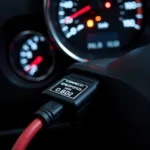Connecting an OBD2 scanner to your Freightliner truck via USB offers a powerful way to diagnose and troubleshoot issues. Whether you’re a seasoned mechanic or a truck owner looking to take maintenance into your own hands, an OBD2 to USB connection can be a valuable tool. This guide will walk you through everything you need to know about using an OBD2 to USB setup with your Freightliner truck.
Understanding OBD2 and Your Freightliner
OBD2, or On-Board Diagnostics, is a standardized system found in most vehicles manufactured after 1996, including Freightliner trucks. It allows you to access valuable data from your truck’s Engine Control Unit (ECU), which manages various engine functions.
A USB connection provides a reliable and convenient way to link your Freightliner’s OBD2 port to a computer or other compatible devices. This connection enables you to:
- Read and clear diagnostic trouble codes (DTCs): Identify and understand the cause of warning lights on your dashboard.
- Monitor live data streams: Track engine parameters like speed, RPM, coolant temperature, and more in real time.
- Perform advanced diagnostics: Depending on your software, you can access and test specific vehicle systems for in-depth troubleshooting.
Choosing the Right OBD2 to USB Cable for Freightliner
Not all OBD2 to USB cables are created equal. Freightliner trucks, like many commercial vehicles, often use a 9-pin diagnostic port instead of the standard 16-pin OBD2 port found in most passenger cars.
Key considerations when choosing a cable:
- Compatibility: Ensure the cable explicitly states compatibility with Freightliner trucks and the specific model year of your vehicle.
- 9-Pin to 16-Pin Adapter: If your Freightliner has a 9-pin port, you’ll need an adapter to connect a standard 16-pin OBD2 cable.
- Chipset Quality: The cable’s chipset affects data transfer speed and reliability. Opt for a cable with a reputable chipset (e.g., FTDI) for optimal performance.
- Cable Length: Choose a cable length that provides sufficient reach for your needs.
Installing Necessary Software
To communicate with your Freightliner’s ECU, you’ll need specialized software. Various options are available, ranging from free open-source programs to professional-grade diagnostic suites.
Popular software choices for Freightliner diagnostics:
- Freightliner DiagnosticLink: Freightliner’s official diagnostic software offers comprehensive coverage for various truck models.
- Cummins INSITE: Ideal for Freightliners equipped with Cummins engines.
- Detroit Diesel Diagnostic Link (DDDL): Designed for Freightliner trucks with Detroit Diesel engines.
- Third-party software: Several reputable options are available, each with its own features and pricing. Research and choose one that aligns with your needs and budget.
Connecting Your Freightliner to Your Computer
- Locate your Freightliner’s diagnostic port: The location varies by model year, but it’s commonly found under the dashboard on the driver’s side.
- Connect the OBD2 to USB cable: If needed, first connect the 9-pin adapter to your truck’s diagnostic port, then connect the OBD2 end of the cable.
- Connect the USB end to your computer: Your computer should automatically detect and install the necessary drivers.
- Launch your chosen diagnostic software: Follow the software’s prompts to establish communication with your Freightliner’s ECU.
Diagnosing Your Freightliner
Once connected, you can use the software to read and clear DTCs, view live data streams, and perform other diagnostic functions.
Tips for effective diagnostics:
- Consult your Freightliner service manual: This manual provides valuable information on DTCs specific to your truck model.
- Start with a basic scan: This will identify any stored or pending fault codes.
- Research DTCs thoroughly: Online resources and forums can provide insights into common causes and solutions.
- Proceed with caution: If you’re unsure about any diagnostic or repair procedures, consult a qualified mechanic.
Common Uses of OBD2 to USB for Freightliner
- DIY Maintenance: Monitor engine health, track fuel economy, and diagnose minor issues yourself.
- Fleet Management: Centralize vehicle diagnostics, track maintenance schedules, and optimize fleet performance.
- Advanced Troubleshooting: Perform in-depth diagnostics to identify and resolve complex mechanical problems.
Conclusion
Utilizing an OBD2 to USB connection for your Freightliner truck provides a gateway to valuable diagnostic information. By understanding the basics of OBD2, choosing the right equipment, and using the software effectively, you can take control of your truck’s maintenance and troubleshoot problems like a pro.
Remember to consult your Freightliner service manual and seek professional assistance when needed to ensure safe and accurate diagnostics and repairs.


